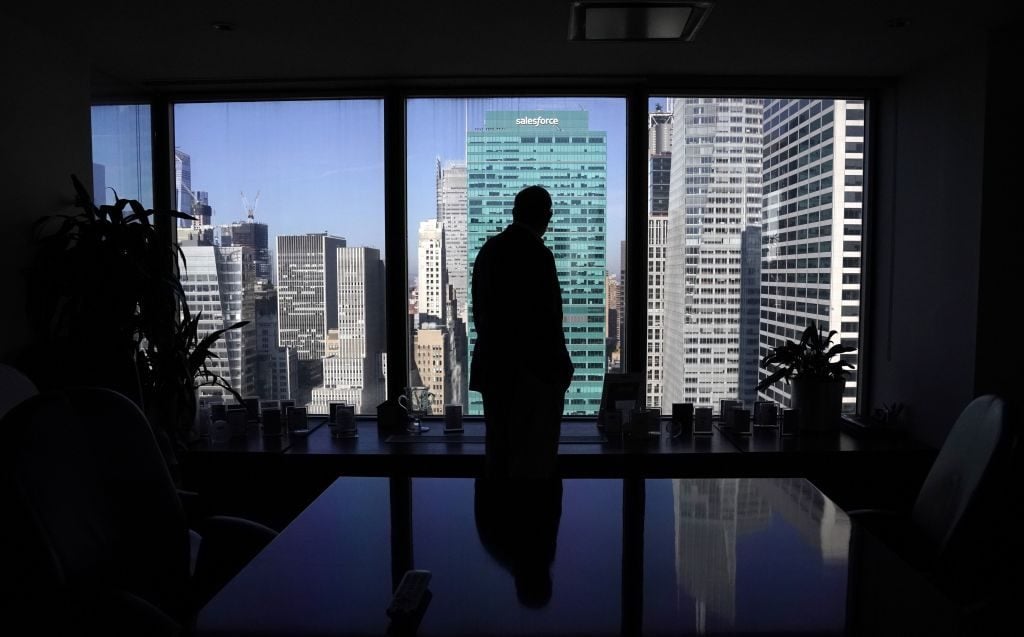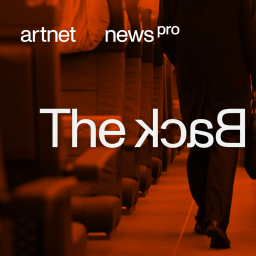Every Wednesday morning, Artnet News brings you The Gray Market. The column decodes important stories from the previous week—and offers unparalleled insight into the inner workings of the art industry in the process.
This week, deciding it’s time to revise our priors…
STATUS UPDATE
Between spring and fall 2020, pundits and professionals across industries (including the arts) entertained visions of a future radically restructured by the aftermath of COVID-19. About a year later, however, the trends shaping post-pandemic reality in major U.S. cities are looking an awful lot like the same ones that were already in progress before the coronavirus knocked daily life sideways—a prospect with weighty implications for the arts.
When it came to how high-income countries would function differently, even after the distribution of safe, effective vaccines, I think it’s fair to say that three ideas were taken practically for granted inside the depths of the crisis:
- Air travel for business and pleasure would require multiple years to recover to pre-pandemic levels, if either one ever managed to fully recover at all.
- Remote work would transition from a temporary necessity to an ongoing fixture of the economy for white-collar knowledge workers of all types.
- Between mass work-from-home and lingering fears about the public-health risks of urban density, premier cities like New York, San Francisco, and Los Angeles would permanently lose tens of thousands of residents to a combo of the suburbs, cheaper yet ascendant metros like Austin and Miami, and long-struggling locales ripe for revitalization.
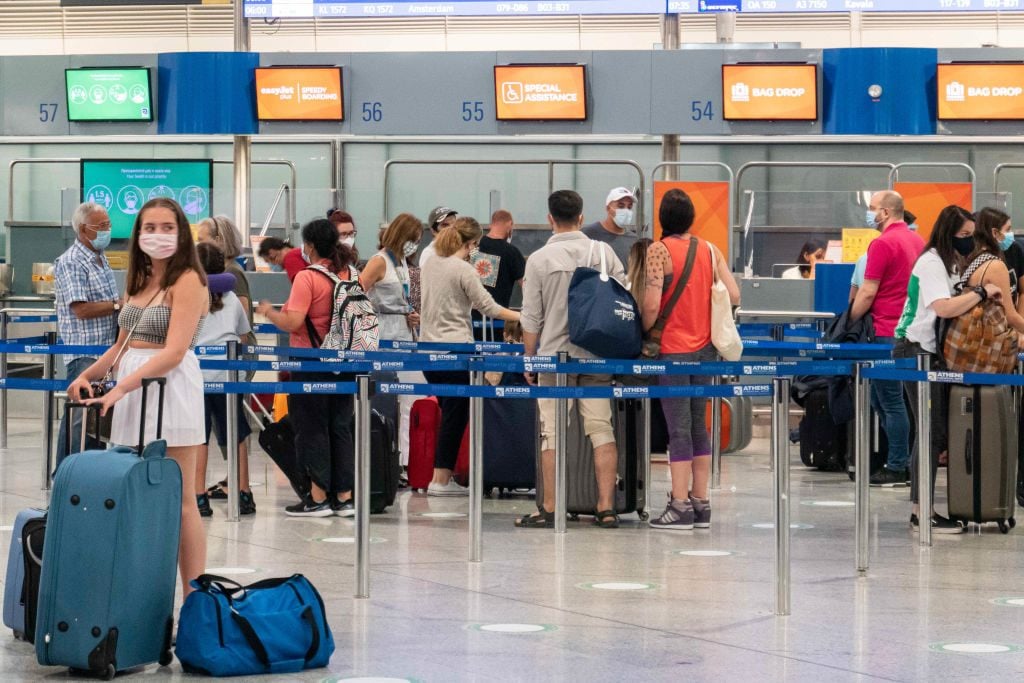
Passengers at the main departure hall in the terminal of Athens International Airport ATH LGAV in Greece. (Photo by Nicolas Economou/NurPhoto via Getty Images)
Midway through the very next summer, though, this triple threat already appears to be more empty promises than prescient prognosticating.
Air travel is the simplest vector to assess. The CEO of Delta Airlines announced in the company’s earnings call last week that “domestic leisure travel is fully recovered to 2019 levels,” propelling the company to its first quarterly profit since COVID reached the U.S. While the long-term fate of overall business travel ironically remains up in the air, art-market players started soaring to sell almost immediately after the initial panic settled. U.S.-based art pros have also booked scores of flights for fall’s must-see (and must-network) domestic events too, cementing a post-pandemic travel mentality in much of our industry regardless of whether or not other trades follow suit.
The other two expected societal pivots—the large-scale demise of in-office work and in-city living—are more complicated to parse, but they mostly appear to be hurtling down the trash chute together in two of the nation’s wealthiest cities. As wealth goes, of course, art follows. Based on how well recent real-estate trends match up with their pre-pandemic priors, then, it would be wise for those in the trade to abandon last year’s conversation about a brave new post-COVID world and prepare for the resurgence of one we thought we were leaving behind.
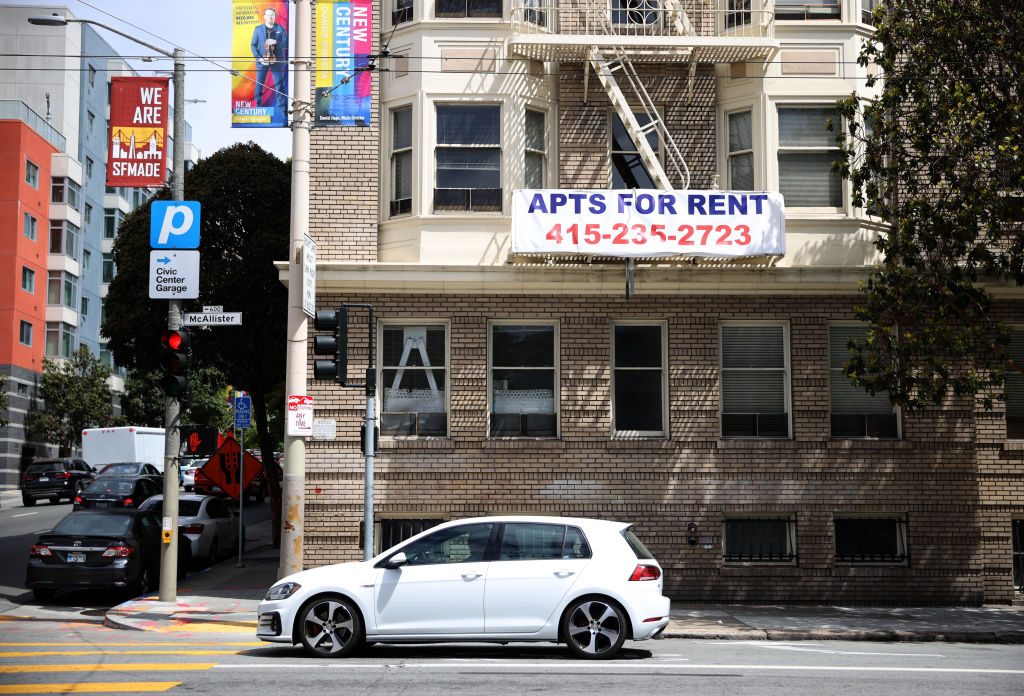
A “for rent” sign posted on the exterior of an apartment building on June 2, 2021, in San Francisco. (Photo by Justin Sullivan/Getty Images)
SUSPENDED ANIMATION
It’s been a strange 16 months in commercial and residential real estate. Data on migration patterns before, during, and after the domestic onset of COVID confirm there was measured legitimacy to predictions of an exodus from urban strongholds in the U.S. Just make sure you place a heavy emphasis on “measured.”
It turns out that out-migration only drained two cities to an outsized and uncharacteristic extent: New York and San Francisco. Just as important, neither the reasons for these select mass departures, nor their duration, look much like what the apocalyptic “end of cities” narrative set us up to believe.
After analyzing roughly 30 million change-of-address requests processed by the U.S. Postal Service last year, the Upshot crew at the New York Times concluded the following about the nation in mid-April of this year:
In short, as disruptive as the pandemic has been in nearly every aspect of life, it doesn’t appear to have altered the underlying forces shaping which places are thriving or struggling … [T]he metro areas that gained the most net movers in 2020—or lost the most—are almost entirely the same as those in 2019.”
Eric Willett, the research director of domestic real-estate titan CBRE, said the metrics showed “how dramatically durable these long-term trends are, even in the face of a once-in-a-lifetime pandemic.”
So if you were thinking that COVID would redraw the map of wealth in America, making cities that suffered the most into exciting new hubs of cultural patronage and art-market activity, think again. As Willett put it, “In many ways, the fundamentals in the data show that Austin is the next Austin.”
What happened in New York and San Francisco, then? A separate study by the Federal Reserve Bank of Cleveland (this time analyzing address changes made on credit reports) found that the two cities’ significant migration losses had less to do with an unusual swell in the number of established residents bailing than it did with an unusual drought in the number of new residents arriving.
Which makes sense if you think about it. Why uproot yourself to one of the two most expensive cities in America during a year when much of what makes them appealing (restaurants, nightlife, cultural attractions, a wider and better dating pool) won’t even be available to you, especially if you work at a company or study at a school where it was okay to be fully remote? (Also notable but unmentioned, probably because it would have failed to surface in changes to American credit reports: COVID restrictions dramatically slowed immigration to the U.S. from abroad in 2020, and continue to do so today.)
The crucial point here is that delaying an arrival to Gotham or the Bay is not the same thing as aborting the move forever. In fact, the Upshot’s analysts deemed it “likely” that “new hires and young adults who didn’t leave Cleveland or St. Louis for New York or Boston in 2020 [will] do so this coming year.”
Three months later, their forecast looks prophetic.
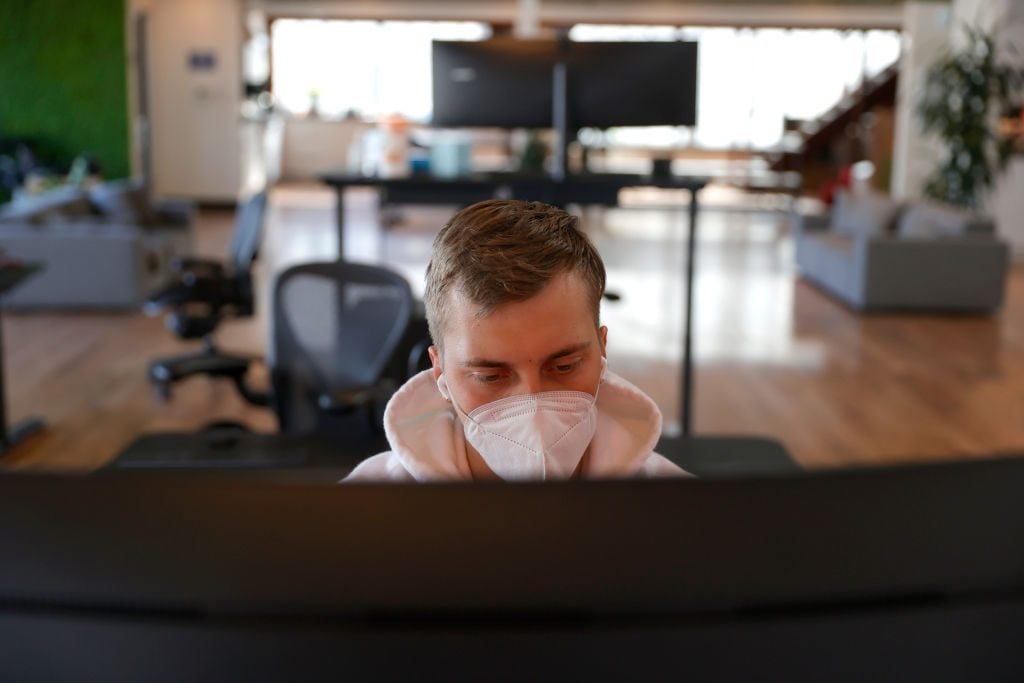
An office worker in San Francisco on March 24, 2021. (Photo by Justin Sullivan/Getty Images)
PRODIGAL SONS AND DAUGHTERS
As of publication time here in New York, much of Wall Street is either already back in the office or arriving imminently. Thousands of employees at Goldman Sachs and Barclays returned to their desks last month. Blackstone recalled all of its fully vaccinated bankers to headquarters afterward. And Morgan Stanley chairman and CEO Jamie Gorman “expects most of his staff to be back by Labor Day” per the Wall Street Journal.
A similar scene is playing out in the Bay Area too, as tech workers flood back into San Francisco and Silicon Valley from their pandemic hideaways. Even more than on Wall Street, the data makes plain the turnabout in NorCal.
More cars (and luxury shuttles operated by major tech companies) darted across the Golden Gate Bridge this May than during any month since February 2020, per Kellen Browning in the New York Times Magazine. Recent numbers from the U.S. Census Bureau and online real-estate marketplace Zillow showed that May 2021 reversed a roughly yearlong downward trend in rental prices in neighborhoods favored by techies. The California Association of Realtors also reported that the median home price in San Francisco has rebounded from a low of $1.58 million in December to hit $1.9 million of late, a figure loftier than before COVID-19 struck.
Those numbers may surprise you, even if you’ve been making a strong effort to stay abreast of the big national picture. As the cofounder of an early-stage, Palo Alto-based investment fund told the Times Magazine, “I think people were pretty noisy about quitting the Bay Area… But they’ve been very quiet in admitting they want to move back.”
However, one constituency not at all caught off guard by this trend are the tech colossi that bet big on a mass reversal of their workforces’ 2020 migration patterns. Google, which will welcome its staff back in September, announced earlier this year it would commit $1 billion to new commercial real estate in California in 2021; the plan is headlined by a pair of new office campuses in Mountain View and more than 7.3 million square feet of office space in nearby San Jose. Twitter, whose workforce returned to the company’s headquarters last week despite CEO Jack Dorsey approving the option to work from home “forever” last spring, will debut major new offices in San Jose and Oakland in 2022.
In fact, Silicon Valley has become a powerful driver of New York’s back-to-the-office culture too. The industry accounted for approximately 330,000 jobs and over 29 million square feet of office space being leased in the Empire City as of March 2021, per Forbes. Even more remarkable, just four tech companies (Amazon, Apple, Facebook, and Tik Tok) accounted for one-sixth of all NYC office space to enter contract in 2020.
The bottom line is that New York and San Francisco are in the process of re-magnetizing a critical mass of the young money that has made them, respectively, the U.S. art industry’s gravitational center and (still) next great hope. Since this outcome runs counter to so much of what was drilled into us about the alleged “new normal” of 2021 (including by me, I should admit), it’s important for people inside and outside the culture industry to ask…
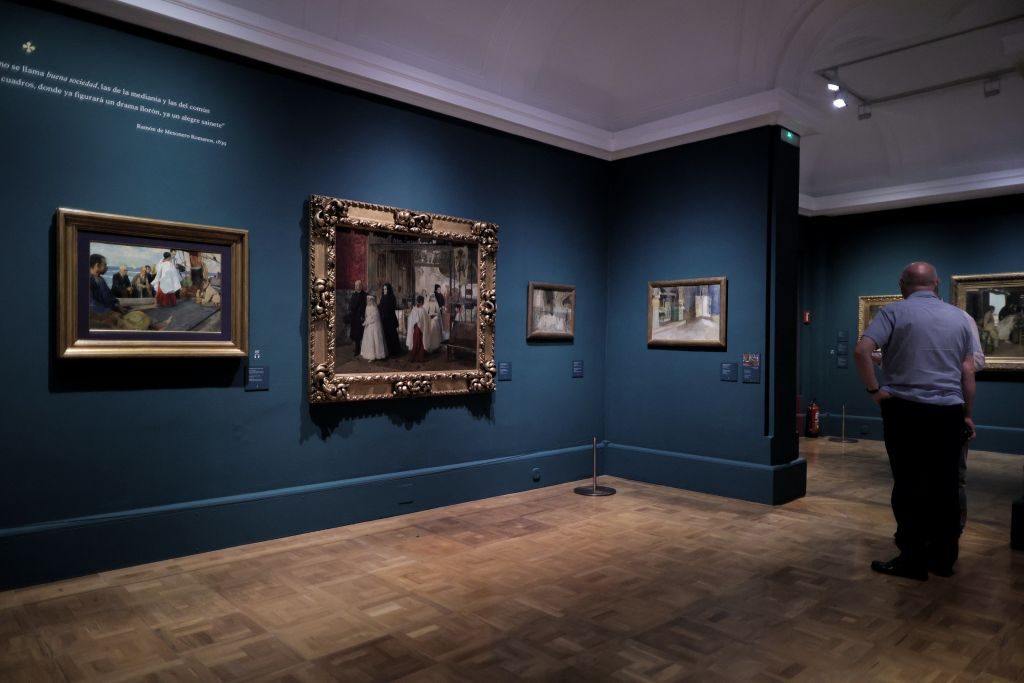
A visitor to the Sorolla Museum on July 12, 2021. (Photo By Eduardo Parra/Europa Press via Getty Images)
WHAT DID WE MISS?
When it comes to staffers’ decisions about when (or whether) to return to New York and greater San Francisco, the above-mentioned major employers in finance and tech obviously placed their thumbs on the scales with their real estate strategies. Veteran bankers are adding more pressure based on their calcified beliefs about the unparalleled value of in-person work. The Wall Street Journal recently reported that ultra-demanding analyst jobs at a behemoth like Goldman are seen as:
a crucial feeder to other areas of finance, with top junior bankers graduating after a couple of years to bigger paydays at private-equity firms and hedge funds. Some of those firms have been hesitant to hire young people who have never worked regularly in an office, Wall Street recruiters say. Like a medical student’s residency in a hospital, the training that junior bankers get in the office is irreplaceable, said Danielle Caston Strazzini, a managing partner and co-founder at private-equity recruiting firm BellCast Partners.
Yet focusing solely on these factors would mean ignoring a crucial variable in the equation. Too often, we anticipate that other people’s choices (especially professional ones) will be determined by a machine-like calculus about costs and benefits. This expectation overlooks that humans are social animals whose emotions frequently outweigh cold logic.
As the WSJ noted, young bankers working remotely will miss out on expensing black cars home or lavish client dinners out, but even more important may be their lost opportunity to form lasting friendships by fighting alongside their colleagues in the financial trenches. One managing partner compared the analysts’ shared in-office gauntlet to “pledging a fraternity together,” calling the job “a huge part of your social life” in a formative period. I’m reasonably sure the same can be said for many, if not most, of the tech-savvy twentysomethings eager to once again toil away in the Bay, too.
Age and social expectations cut both ways in New York and San Francisco’s migration patterns. In their mid-April analysis, the Upshot team found that the areas of both cities whose residents left in the largest numbers were “richer and more central,” including Tribeca in the former and Pacific Heights in the latter. A huge number of those who called it quits in each also merely moved to suburbs or exurbs that would still allow relatively easy trips back into the urban core.
This too strikes me as less a product of the pandemic than of the natural progression of life in these metros. By their mid-to-late thirties, large numbers of professionals once thirsty for nonstop nightlife and the fastest possible ascent up the career ladder have reached comfortable positions and pivoted to domestic partnerships and children. City life tends to offer far less to people on the latter side of that divide. It seems like after logging 15 consecutive years of residency here in New York, about 65 percent of the population is required by law to move upstate (whereas in L.A. you are simply required to buy a statement hat).
The numbers support this conclusion. CBRE relayed that “the vast majority of” the 170,000-plus people who left “the vicinity of San Francisco, Berkeley, and Oakland” last year stayed in California. The Upshot charted a slew of municipalities in upstate New York, the Hamptons, and Connecticut that saw their net in-migration rise by between eight percent and 32 percent year over year.
What does it all mean for the U.S. art industry? Probably that the traditional power centers will continue to stretch their legs but otherwise stay put. No surprise, for instance, that Upstate Art Weekend continues to gain power, with more dealers adding northern spaces, and more activations cropping up on an as-valuable basis (such as the New Art Dealers Alliance’s freshly announced collaboration with the Foreland arts complex in Hudson). Just don’t expect to get an announcement about the launch of Frieze Wichita anytime soon.
By no means am I arguing that business in the arts or any other sector is beyond the grasping hands of COVID, either. On Monday, concerns about the Delta variant’s impact on commerce seem to have been largely responsible for pushing the S&P 500 to its steepest one-day dive since May, and London’s “Freedom Day” was tainted by the need for thousands of residents (including, ironically, prime minister Boris Johnson) to isolate due to contact-tracing protocols.
But the long-term trends in U.S. migration have already shown they will withstand the temporary upheaval of the pandemic. Within the art trade, the immunities also kicked in (metaphorically speaking) for domestic air travel long ago. In short, the future is here. It’s just easy to miss because, in so many ways, it’s the spitting image of the past.
[The New York Times Magazine | The Upshot]
That’s all for this week. ‘Til next time, remember: one of the strongest forces known to humankind is inertia.
